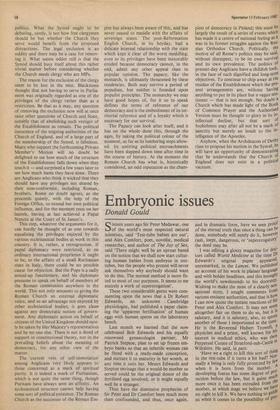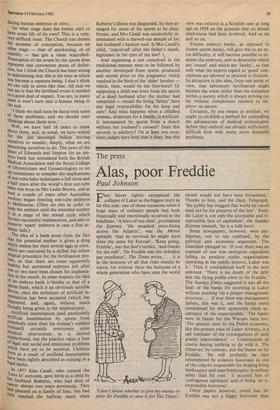Embryonic issues
Donald Gould
C ixteen years ago Sir Peter Medawar, one
of the world's most respected natural scientists, said 'Test-tube babies are out', and Alex Comfort, poet, novelist, medical researcher, and author of The Joy of Sex, said 'There might well be an uproar based on the notion that we shall now start cultur- ing human babies from embryos in test- tubes, but the people who protest will never ask themselves why anybody should want to do this. The normal method is more fit- ted to most of our purposes. It seems to me entirely a work of supererogation'.
These two considerable gurus were com- menting upon the news that a Dr Robert Edwards, an unknown Cambridge physiologist, had published a paper claim- ing the 'apparent fertilisation' of human eggs with human sperm on the laboratory bench.
Last month we learned that the now celebrated Bob Edwards and his equally renowned gynaecologist partner, Mr Patrick Steptoe, plan to set up frozen em- bryo banks so that an infertile woman can be fitted with a ready-made conception, and nurture it to maturity in her womb, at any time it suits her. Messrs Edwards and Steptoe envisage that a would-be mother so served could be the original donor of the fertilised egg involved, or it might equally well be a stranger.
Thus have the dismissive prophecies of Sir Peter and Dr Comfort been much more than confounded, and thus, once again, and in dramatic form, have we seen proof of the eternal truth that once a thing can be done, somebody will surely do it, hovvever, rash, inept, dangerous, or `supererogatory the deed may be.
I was editing a glossy magazine for doc- tors called World Medicine at the time pr Edwards's original paper appeared, unremarked, in the Lancet. We published an account of his work in plainer language and with bolder headlines, and this brought the world's newshounds to his doorsten. Wishing to make the most of a clearly sen- sational story, I sought comments from various eminent authorities, and that is how I can now quote the instant reactions of Sir Peter and Alex Comfort. It may not seem altogether fair on them to do so, but it is salutary, and it is, salutary, also, to quote another of those I importuned at the time. He is the Reverend Hubert Trowel', ,a physician and a priest, well known for his interest in medical ethics, who was then Perpetual Curate of Stratford-sub-Castle 111 Wiltshire. He said, in part: `Have we a right to kill this sort of thing in the test-tube if it turns a bit bad? Nor- mally a being is only fully protected by when it is born from the mother. 1": developing foetus has some degree of tection before the law, but it gains much more once it has been extruded fromthe mother, at which stage we believe we haAeve no right to kill it. We have nothing to guide us when it comes to the possibility of pro clueing human embryos in vitro.
'At what stage does the foetus start to have some life of its own? This is a very, very difficult issue. The Church has chosen the moment of conception, because no other stage — that of quickening, or of viability — has got a clean watershed. Penetration of the ovum by the sperm does represent one convenient point of defini- tion, but I think the Church has been wrong to maintaining that this is the time at which You become a separate being. I don't think We can talk in terms like that. All that we can say is that the fertilised ovum is entitled to a good deal of respect. You see, in many
cases it won't turn into a human being in the end.
'I think we shall soon be faced with some of these problems, and we should start thinking about them now.'
Well, we have had 16 years to think about them, and, as usual, we have waited for the fait 'accompli before stirring Ourselves to wonder, deeply, what we are Permitting ourselves to do. The news of the Plans of Edwards and Steptoe for an em- bryo bank has stimulated both the British Medical Association and the Royal College of Obstetricians and Gynaecologists to set uP committees to consider the implications of test-tube baby techniques a full three and a half years after the world's first test-tube b, abY was born to Mrs Leslie Brown, and at least a couple of years after Australian Workers began freezing test-tube embryos la Melbourne. (They do this in order to .keep the embryo until the intended mother at a stage of her sexual cycle which iavours successful implantation, and also to Preserve 'spare' embryos in case a first at- tempt fails.) The idea of a bank arose from the fact that the potential mother is given a drug Which makes her shed several eggs at once, winch are recovered by a skilled but minor surgical procedure for the fertilisation pro- cess, so that there are some apparently healthy but unwanted embryos left after One or two have been chosen for implanta- tion in the womb. In some respects the idea of an embryo bank is 'similar to that of a 'Perm bank, which is an obviously sensible device, once the technique of artificial in- semination has been accepted (which has happened, and, again, without much thought being given to the implications). Artificial insemination (and particularly artlficial insemination by sperm from '°Inebody other than the woman's wedded husband) certainly overcomes some PllYsical obstructions to a desired motherhood, but the practice raises a host Of legal and social and emotional problems w. Inch have yet to be resolved. Children porn as a result of artificial insemination have been rightly described as existing in a legal limbo.
In 1977 Kim Casali, who created the her Is' cartoons, gave birth to a child by 'ler husband Roberto, who had died of cancer almost two years previously. They had planned on a family of four, but had °I.11Y reached the halfway mark when
Roberto's illness was diagnosed. So they ar- ranged for some of his sperm to be deep- frozen, and Mrs Casali was successfully in- seminated with a thawed-out sample of her late husband's banked seed. Is Mrs Casali's child, 'conceived' after the father's death, legitimate in the eyes of the law? \ And supposing a son conceived in the traditional manner were to be followed by another developed from sperm produced and stored prior to the pregnancy which resulted in the birth of the 'elder' brother which, then, would be the first-born? Or supposing a child was born from the sperm of a dead husband after the mother had remarried — would the living 'father' have any legal responsibility for his keep and care? And what happens when a childless woman, desperate for a family, is artificial- ly inseminated by sperm from a donor without her husband's consent? Does this amount to adultery? On at least two occa- sions judges have held that it does, but this view was refuted in a Scottish case as long ago as 1958 on the grounds that no sexual intercourse had been involved. And so on and so on.
Frozen embryo banks, as opposed to frozen sperm banks, will give rise to an ex- tra difficulty. It will become possible to ex- amine the embryos, and to determine which are 'sound' and which are 'faulty', so that only what the experts regard as 'good' con- ceptions are allowed to proceed to fruition. So attractive is this idea, from one point of view, that laboratory fertilisation might become the norm rather than the exception within a society which is always striving (so far without conspicuous success) to im- prove on nature.
Certainly, by one means or another, we ought to establish a method for controlling the adventurism of medical technologists before they embroil our already sufficiently difficult lives with many more insoluble problems.











































 Previous page
Previous page